
|
It approached to Earth down to 0.3 a.u. in mid February, and brightened up to 5.5 mag (Feb. 13, Juan Jose Gonzalez). Now it is fading. But it is still bright as 11.3 mag (Apr. 8, Thomas Lehmann). In the Southern Hemisphere, it is not observable now. It will be unobservable soon also in the Northern Hemisphere.
Date(TT) R.A. (2000) Decl. Delta r Elong. m1 Best Time(A, h)
Apr. 20 4 24.67 33 26.1 2.274 1.666 41 12.1 20:05 (116, 23)
Apr. 27 4 25.90 33 34.6 2.445 1.730 35 12.5 20:13 (119, 17)
|

|
Now it is not observable. It will appear in the morning sky again at 13-14 mag in August.
Date(TT) R.A. (2000) Decl. Delta r Elong. m1 Best Time(A, h)
Apr. 20 2 45.53 14 29.2 2.978 2.019 14 12.5 20:05 (112, -6)
Apr. 27 3 2.32 15 30.5 3.000 2.024 11 12.5 20:13 (116, -8)
|

|
It brightened up to 7.7 mag in June (June 19, Juan Jose Gonzalez). Now it is fading. But it is still bright as 12.8 mag (Apr. 7, Chris Wyatt). In the Southern Hemisphere, it stays observable in good condition for a long time until the comet will fade out. In the Northern Hemisphere, it is not observable for a long time until autumn when the comet fades out down to 16 mag.
Date(TT) R.A. (2000) Decl. Delta r Elong. m1 Best Time(A, h)
Apr. 20 4 55.30 -42 28.8 3.791 3.549 68 12.6 20:05 ( 47,-14)
Apr. 27 5 4.24 -40 25.5 3.883 3.605 66 12.7 20:13 ( 52,-17)
|
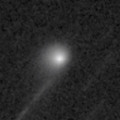
|
Now it is not observable. It will appear in the morning sky in mid May in the Southern Hemisphere, or in late June in the Northern Hemisphere.
Date(TT) R.A. (2000) Decl. Delta r Elong. m1 Best Time(A, h)
Apr. 20 1 47.58 -6 50.8 4.633 3.691 18 13.0 3:52 (257,-29)
Apr. 27 1 52.54 -5 19.6 4.588 3.657 19 12.9 3:42 (257,-26)
|
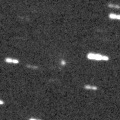
|
Now it is bright as 13.5 mag (Mar. 3, Taras Prystavski). It stays 13 mag for a long time in 2019. In the Southern Hemisphere, it is observable in excellent condition. In the Northern Hemisphere, it is not observasble until summer in 2020.
Date(TT) R.A. (2000) Decl. Delta r Elong. m1 Best Time(A, h)
Apr. 20 7 38.15 -56 22.2 2.811 3.111 97 13.1 20:05 ( 19, -6)
Apr. 27 7 31.69 -55 21.6 2.841 3.097 95 13.1 20:13 ( 24, -8)
|

|
Now it is 13.9 mag (Apr. 6, Martin Masek). It stays 13-14 mag until summer. It is observable in excellent condition in the Southern Hemisphere. In the Northern Hemisphere, it will be getting lower gradually, and it will be unobservable in July.
Date(TT) R.A. (2000) Decl. Delta r Elong. m1 Best Time(A, h)
Apr. 20 16 54.23 -33 47.9 2.609 3.367 132 13.4 3:05 ( 0, 21)
Apr. 27 16 40.69 -35 47.8 2.546 3.385 140 13.3 2:24 ( 0, 19)
|

|
It is not observable now. It will appear in the morning sky in May.
Date(TT) R.A. (2000) Decl. Delta r Elong. m1 Best Time(A, h)
Apr. 20 0 14.96 8 27.0 6.675 5.767 23 13.8 3:52 (258, -2)
Apr. 27 0 19.92 9 4.8 6.630 5.767 28 13.8 3:42 (260, 1)
|
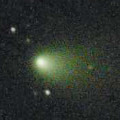
|
Now it is 12.8 mag (Apr. 7, Chris Wyatt). It is observable in excellent condition in the Northern Hemisphere. It locates somewhat low in the Southern Hemisphere.
Date(TT) R.A. (2000) Decl. Delta r Elong. m1 Best Time(A, h)
Apr. 20 11 0.54 25 25.3 1.470 2.204 124 14.0 21:08 ( 0, 80)
Apr. 27 11 1.96 23 46.6 1.541 2.219 119 14.2 20:42 ( 0, 79)
|

|
Now it is 13.6 mag (Feb. 27, S. Szabo). It is expected to brighten up to 7 mag in 2020. Now it is not observable. It will appear in the morning sky in July.
Date(TT) R.A. (2000) Decl. Delta r Elong. m1 Best Time(A, h)
Apr. 20 3 26.76 7 47.6 5.590 4.693 24 14.6 20:05 (101, -2)
Apr. 27 3 31.66 8 36.8 5.567 4.629 19 14.5 20:13 (106, -7)
|
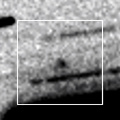
|
It will brighten up to 14 mag from May to June. However, it locates very low in the Northern Hemisphere, and it is not observable in the Southern Hemisphere.
Date(TT) R.A. (2000) Decl. Delta r Elong. m1 Best Time(A, h)
Apr. 20 0 5.72 43 5.0 2.118 1.479 38 14.8 3:52 (230, 19)
Apr. 27 0 34.55 47 33.5 2.049 1.431 39 14.6 3:42 (225, 20)
|

|
Now it is 14.0 mag (Mar. 8, Toshihiko Ikemura, Hirohisa Sato). It will be fading after this. In the Northern Hemisphere, it will be unobservable soon. In the Southern Hemisphere, it stays observable for a long time until it fades out.
Date(TT) R.A. (2000) Decl. Delta r Elong. m1 Best Time(A, h)
Apr. 20 5 37.18 -19 44.9 4.195 3.864 64 14.8 20:05 ( 60, 7)
Apr. 27 5 39.59 -19 42.6 4.313 3.912 60 15.0 20:13 ( 65, 2)
|

|
It stays 15 mag from 2018 to 2019, and it will be observable for a long time in the Southern Hemisphere. In the Northern Hemisphere, it will never be observable again. It has not been observed since last October.
Date(TT) R.A. (2000) Decl. Delta r Elong. m1 Best Time(A, h)
Apr. 20 23 41.38 -48 15.1 4.280 3.977 65 14.9 3:52 (313,-25)
Apr. 27 23 49.70 -47 30.5 4.232 3.988 69 14.8 3:42 (313,-23)
|
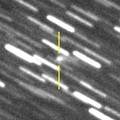
|
Now it is 15.3 mag (Apr. 6, Toshihiko Ikemura, Hirohisa Sato). It will brighten up to 15 mag from May to June, and it will be observable in good condition.
Date(TT) R.A. (2000) Decl. Delta r Elong. m1 Best Time(A, h)
Apr. 20 21 4.63 11 11.8 1.650 1.605 69 15.1 3:52 (285, 39)
Apr. 27 21 24.45 14 55.4 1.618 1.590 70 15.1 3:42 (280, 40)
|

|
Now it is 14.6 mag (Apr. 7, Thomas Lehmann). It will be fading slowly after this. It is observable in good condition in the Northern Hemisphere. In the Southern Hemisphere, it stays extremely low for a while.
Date(TT) R.A. (2000) Decl. Delta r Elong. m1 Best Time(A, h)
Apr. 20 15 36.47 48 23.0 3.806 4.339 115 15.1 1:47 (180, 77)
Apr. 27 15 29.21 48 14.1 3.855 4.391 116 15.2 1:12 (180, 77)
|

|
It approached to Earth down to 0.08 a.u. in mid December, and it brightened up to 3.4 mag (Dec. 14, Seiichi Yoshida). it looked so large as 3 times of Moon. Now it is fading. It has already faded down to 14.4 mag (Apr. 2, Toshihiko Ikemura, Hirohisa Sato). In the Northern Hemisphere, it stays observable in excellent condition. It locates low in the Southern Hemisphere.
Date(TT) R.A. (2000) Decl. Delta r Elong. m1 Best Time(A, h)
Apr. 20 10 18.37 30 3.2 1.228 1.883 114 15.2 20:26 ( 0, 85)
Apr. 27 10 26.06 28 8.2 1.345 1.942 110 15.8 20:13 ( 12, 83)
|
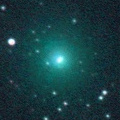
|
Now it is 14.4 mag (Apr. 2, Ken Harikae). It stayed at 10-12 mag from autum to winter. But it is fading now. In the Northern Hemisphere, it stays observable for a long time until it fades out. But it stays extremely low. It will never be observable again in the Southern Hemisphere.
Date(TT) R.A. (2000) Decl. Delta r Elong. m1 Best Time(A, h)
Apr. 20 0 46.89 45 29.5 3.177 2.446 36 15.2 3:52 (224, 15)
Apr. 27 1 5.27 46 4.9 3.254 2.506 35 15.5 3:42 (223, 15)
|
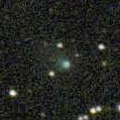
|
It is expected to brighten up to 10 mag in autumn. Now it is 15.9 mag (Apr. 8, Thomas Lehmann). In the Northern Hemisphere, it stays observable for a long time while the comet is brightening. In the Southern Hemisphere, it it not observable until mid September.
Date(TT) R.A. (2000) Decl. Delta r Elong. m1 Best Time(A, h)
Apr. 20 3 21.74 73 42.5 2.638 2.374 63 15.4 20:05 (161, 31)
Apr. 27 3 30.82 71 40.5 2.653 2.305 59 15.2 20:13 (160, 28)
|

|
Now it is 15.2 mag (Apr. 2, Toshihiko Ikemura, Hirohisa Sato). It will be fading slowly after this. It is observable in excellent condition until spring in the Northern Hemispehre. In the Southern Hemisphere, it will be hardly observable after this.
Date(TT) R.A. (2000) Decl. Delta r Elong. m1 Best Time(A, h)
Apr. 20 8 51.91 39 25.8 5.046 5.224 94 15.4 20:05 (113, 76)
Apr. 27 8 48.55 38 32.7 5.204 5.264 87 15.5 20:13 (107, 69)
|

|
Now it is 14.2 mag (Feb. 4, ATLAS-MLO, Mauna Loa). It will be fading gradually after this. It is observable in excellent condition in the Northern Hemisphere. In the Southern Hemisphere, it is not observable until summer.
Date(TT) R.A. (2000) Decl. Delta r Elong. m1 Best Time(A, h)
Apr. 20 9 37.54 56 6.0 2.286 2.575 94 15.7 20:05 (172, 69)
Apr. 27 9 43.61 53 16.1 2.385 2.616 91 15.9 20:13 (158, 70)
|
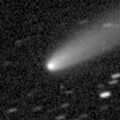
|
It brightened up to 13.2 mag from December to March (Dec. 30, Chris Wyatt). Now it is 14.3 mag (Apr. 7, Chris Wyatt). It will be fading after this, and it will be fainter than 18 mag in May.
Date(TT) R.A. (2000) Decl. Delta r Elong. m1 Best Time(A, h)
Apr. 20 11 20.84 -2 36.2 1.149 2.037 142 15.9 21:28 ( 0, 52)
Apr. 27 11 22.77 -2 24.1 1.231 2.075 135 16.3 21:03 ( 0, 53)
|
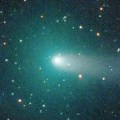
|
It brightened up to 9.5 mag from autumn to winter (Dec. 14, Marco Goiato). Now it is fading. It has already faded down to 14.5 mag (Apr. 2, Toshihiko Ikemura, Hirohisa Sato). In the Northern Hemisphere, it stays observable in good condition for a long time until it fades out. It locates low in the Southern Hemispehre.
Date(TT) R.A. (2000) Decl. Delta r Elong. m1 Best Time(A, h)
Apr. 20 9 16.06 38 5.3 2.114 2.486 99 16.0 20:05 (112, 81)
Apr. 27 9 24.83 36 46.9 2.248 2.545 95 16.4 20:13 (102, 76)
|
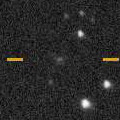
|
Now it is 17.4 mag (Jan. 3, Toshihiko Ikemura, Hirohisa Sato). It stays 16 mag for a long time from 2019 to 2020. It is observable in excellent condition in the Southern Hemisphere. It is hardly observable in the Northern Hemisphere.
Date(TT) R.A. (2000) Decl. Delta r Elong. m1 Best Time(A, h)
Apr. 20 12 38.16 -58 6.4 3.290 4.023 131 16.1 22:44 ( 0, -3)
Apr. 27 12 20.79 -58 20.5 3.265 3.991 130 16.1 21:59 ( 0, -3)
|

|
It brightened up to 9.0 mag from autumn to winter (Nov. 16, Maik Meyer). Now it is fading. It has already faded down to 15.4 mag (Apr. 2, Toshihiko Ikemura, Hirohisa Sato). It is observable in excellent condition in the Northern Hemisphere. It stays low in the Southern Hemisphere.
Date(TT) R.A. (2000) Decl. Delta r Elong. m1 Best Time(A, h)
Apr. 20 6 49.55 22 4.1 2.419 2.317 72 16.1 20:05 ( 85, 47)
Apr. 27 7 2.46 21 31.5 2.550 2.371 68 16.5 20:13 ( 88, 42)
|

|
First return of a new periodic comet discovered in 2014. The condition of this apparition is excelllent. It was expected to brighten rapidly, and to be observable at 15.5 mag in excellent condition in March. But it has not been recovered yet. Now it is fainter than 19 mag (Mar. 28, Jean-Francois Soulier).
Date(TT) R.A. (2000) Decl. Delta r Elong. m1 Best Time(A, h)
Apr. 20 10 18.58 11 48.2 0.926 1.695 122 16.1 20:26 ( 0, 67)
Apr. 27 10 26.02 11 21.3 0.967 1.690 117 16.2 20:13 ( 4, 66)
|
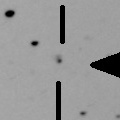
|
Asteroid, but it brightened rapidly. Now it is 17.3 mag (Nov. 14, Kunihiro Shima). It is observable in excellent condition in the Southern Hemisphere. It is hardly observable in the Northern Hemisphere.
Date(TT) R.A. (2000) Decl. Delta r Elong. m1 Best Time(A, h)
Apr. 20 22 28.46 -36 13.4 6.818 6.492 66 16.5 3:52 (309, -7)
Apr. 27 22 28.30 -36 24.7 6.703 6.485 73 16.5 3:42 (312, -5)
|

|
Now it is 17.1 mag (Apr. 3, Toshihiko Ikemura, Hirohisa Sato). It stays 16-17 mag for a long time until 2020. It is observable in good condition in the Northern Hemisphere. It is not observable at all in the Southern Hemisphere.
Date(TT) R.A. (2000) Decl. Delta r Elong. m1 Best Time(A, h)
Apr. 20 10 49.92 71 40.6 8.358 8.451 91 16.7 20:57 (180, 53)
Apr. 27 10 48.08 70 57.9 8.419 8.453 88 16.8 20:28 (180, 54)
|

|
Now it is 18.4 mag (Apr. 4, Toshihiko Ikemura, Hirohisa Sato). It will brighten rapidly after this. It will be observable at 13.5 mag in good condition in autumn.
Date(TT) R.A. (2000) Decl. Delta r Elong. m1 Best Time(A, h)
Apr. 20 17 46.91 -9 8.3 1.980 2.648 121 17.1 3:52 (358, 46)
Apr. 27 17 49.38 -8 23.8 1.867 2.604 127 16.8 3:32 ( 0, 47)
|

|
Now it is 17.3 mag (Apr. 1, Toshihiko Ikemura, Hirohisa Sato). It is observable at 17 mag in good condition in 2019. It locates somewhat low in the Northern Hemisphere.
Date(TT) R.A. (2000) Decl. Delta r Elong. m1 Best Time(A, h)
Apr. 20 15 50.45 -16 15.6 2.939 3.843 150 16.9 2:01 ( 0, 39)
Apr. 27 15 46.76 -16 8.3 2.900 3.851 157 16.9 1:30 ( 0, 39)
|
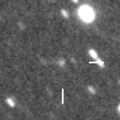
|
It will brighten up to 16.5 mag in June. It is observable in excellent condition in the Southern Hemisphere. It locates low in the Northern Hemisphere. It has not been observed since last October.
Date(TT) R.A. (2000) Decl. Delta r Elong. m1 Best Time(A, h)
Apr. 20 18 39.27 -30 57.9 3.376 3.847 110 17.0 3:52 (347, 23)
Apr. 27 18 31.28 -32 23.4 3.235 3.827 119 16.9 3:42 (353, 22)
|

|
Now it is 16.7 mag (Apr. 3, Toshihiko Ikemura, Hirohisa Sato). It is expected to be observable at 5-6 mag for a long time from 2022 to 2023. In the Northern Hemisphere, it is not observable at the highlight from 2022 summer to 2023 summer. In the Southern Hemisphere, it stays unobservable for a while. But it will be observable in good condition at the highlight.
Date(TT) R.A. (2000) Decl. Delta r Elong. m1 Best Time(A, h)
Apr. 20 18 10.87 56 52.5 11.738 11.840 93 17.1 3:52 (190, 68)
Apr. 27 18 8.82 57 17.5 11.673 11.795 94 17.1 3:42 (183, 68)
|

|
Although it was faint as 16-17 mag in November, it brightened up to 14.7 mag in December (Dec. 12, Toshihiko Ikemura, Hirohisa Sato). Now it is fading. It has already faded down to 16.9 mag (Apr. 2, Toshihiko Ikemura, Hirohisa Sato). In the Northern Hemisphere, it stays observable in excellent condition after this. It stays extremely low in the Southern Hemisphere.
Date(TT) R.A. (2000) Decl. Delta r Elong. m1 Best Time(A, h)
Apr. 20 10 29.31 39 57.0 2.712 3.211 110 17.3 20:37 (180, 85)
Apr. 27 10 30.02 38 55.5 2.821 3.242 105 17.5 20:13 (171, 86)
|

|
Now it is 17.1 mag (Apr. 1, Toshihiko Ikemura, Hirohisa Sato). Fading slowly. It stays observable at 17 mag in good condition until summer.
Date(TT) R.A. (2000) Decl. Delta r Elong. m1 Best Time(A, h)
Apr. 20 11 28.70 10 21.6 9.315 10.094 138 17.4 21:36 ( 0, 65)
Apr. 27 11 27.93 10 32.7 9.406 10.106 131 17.4 21:08 ( 0, 65)
|
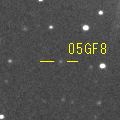
|
First return of a new periodic comet which brightened up to 16.5 mag in 2005. Now it is 17.8 mag (Apr. 1, Toshihiko Ikemura, Hirohisa Sato). It stays 17.5 mag until early summer.
Date(TT) R.A. (2000) Decl. Delta r Elong. m1 Best Time(A, h)
Apr. 20 13 0.71 -8 13.2 2.077 3.066 167 17.5 23:07 ( 0, 47)
Apr. 27 12 57.01 -7 50.7 2.082 3.047 159 17.4 22:36 ( 0, 47)
|
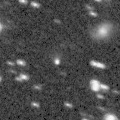
|
It had been brightening even after the perihelion passage, and it brightened up to 16.6 mag (Feb. 1, Toshihiko Ikemura, Hirohisa Sato). Now it is fading. It has already faded down to 18.4 mag (Apr. 1, Toshihiko Ikemura, Hirohisa Sato).
Date(TT) R.A. (2000) Decl. Delta r Elong. m1 Best Time(A, h)
Apr. 20 9 8.19 -0 28.9 1.368 1.948 109 17.4 20:05 ( 20, 53)
Apr. 27 9 19.44 -0 31.4 1.462 1.986 105 17.6 20:13 ( 30, 50)
|

|
In the Southern Hemisphere, it is observable at 17.5 mag in good condition from spring to summer. In the Northern Hemisphere, it is not observable at all. It has not been observed since last September.
Date(TT) R.A. (2000) Decl. Delta r Elong. m1 Best Time(A, h)
Apr. 20 17 16.38 -55 41.6 3.798 4.390 120 17.8 3:27 ( 0, -1)
Apr. 27 17 14.17 -56 13.6 3.729 4.390 125 17.8 2:58 ( 0, -1)
|

|
Now it is 17.7 mag (Apr. 6, Toshihiko Ikemura, Hirohisa Sato). It is expected to brighten up to 13.5 mag in 2021, and it will be observable in good condition in the Southern Hemisphere. In the Northern Hemisphere, it is not observable at the highlight.
Date(TT) R.A. (2000) Decl. Delta r Elong. m1 Best Time(A, h)
Apr. 20 14 2.53 8 28.3 6.553 7.505 160 17.8 0:13 ( 0, 63)
Apr. 27 13 58.99 8 28.1 6.520 7.460 157 17.8 23:38 ( 0, 63)
|
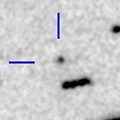
|
Now it is 18.3 mag (Apr. 1, Toshihiko Ikemura, Hirohisa Sato). It brightens up to 18 mag and it is observable in good condition from April to June. It locates somewhat low in the Southern Hemisphere.
Date(TT) R.A. (2000) Decl. Delta r Elong. m1 Best Time(A, h)
Apr. 20 14 7.25 29 18.7 1.823 2.665 139 18.0 0:18 ( 0, 84)
Apr. 27 14 3.40 29 56.5 1.852 2.673 136 17.9 23:42 ( 0, 85)
|

|
Main-belt asteroid. But it shows a straight tail like a comet. Now it is 17.3 mag (Apr. 1, Toshihiko Ikemura, Hirohisa Sato). It stays observable in excellent condition until early summer.
Date(TT) R.A. (2000) Decl. Delta r Elong. m1 Best Time(A, h)
Apr. 20 10 0.52 5 20.3 1.571 2.256 120 18.2 20:08 ( 0, 60)
Apr. 27 10 3.10 6 32.4 1.631 2.240 114 18.3 20:13 ( 15, 61)
|
|
![]()
 60P/Tsuchinshan 2
60P/Tsuchinshan 2 38P/Stephan-Oterma
38P/Stephan-Oterma C/2018 F4 ( PanSTARRS )
C/2018 F4 ( PanSTARRS ) 64P/Swift-Gehrels
64P/Swift-Gehrels P/2014 C1 ( TOTAS )
P/2014 C1 ( TOTAS ) A/2017 U7
A/2017 U7 C/2010 U3 ( Boattini )
C/2010 U3 ( Boattini ) 68P/Klemola
68P/Klemola 74P/Smirnova-Chernykh
74P/Smirnova-Chernykh C/2018 KJ3 ( Lemmon )
C/2018 KJ3 ( Lemmon ) C/2017 K2 ( PanSTARRS )
C/2017 K2 ( PanSTARRS ) 240P/NEAT
240P/NEAT C/2014 B1 ( Schwartz )
C/2014 B1 ( Schwartz ) P/2018 X1 ( LONEOS )
P/2018 X1 ( LONEOS ) 239P/LINEAR
239P/LINEAR 186P/Garradd
186P/Garradd C/2019 F1 ( ATLAS-Africano )
C/2019 F1 ( ATLAS-Africano ) 149P/Mueller 4
149P/Mueller 4 (6478) Gault
(6478) Gault![]()


































